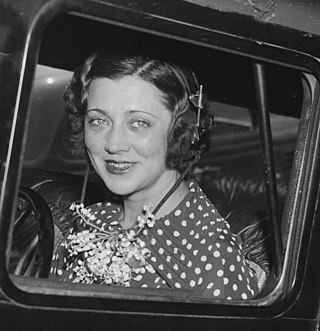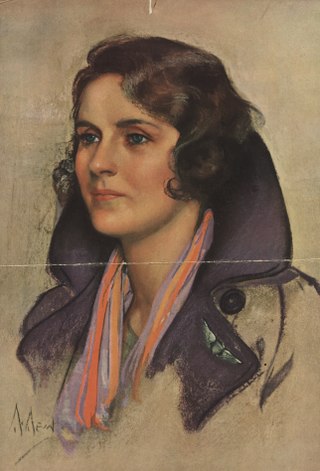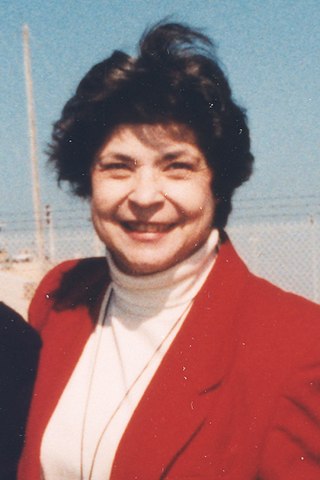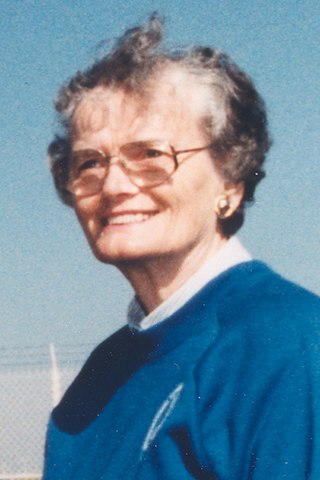
Jacqueline Cochran was an American pilot and business executive. She pioneered women's aviation as one of the most prominent racing pilots of her generation. She set numerous records and was the first woman to break the sound barrier on 18 May 1953. Cochran was the wartime head of the Women Airforce Service Pilots (WASP) (1943–1944), which employed about 1000 civilian American women in a non-combat role to ferry planes from factories to port cities. Cochran was later a sponsor of the Mercury 13 women astronaut program.

Iris Louise McPhetridge Thaden was an American aviation pioneer, holder of numerous aviation records, and the first woman to win the Bendix trophy, alongside Blanche Noyes. She was inducted into the Arkansas Aviation Historical Society's Hall of Fame in 1980.

The Ninety-Nines: International Organization of Women Pilots, also known as The 99s, is an international organization that provides networking, mentoring, and flight scholarship opportunities to recreational and professional female pilots. Founded in 1929, the Ninety-Nines has 153 chapters and 27 regional 'sections' across the globe as of 2022, including a 'virtual' chapter, Ambassador 99s, which meets online for those who are too busy or mobile to be in one region for long.

Blanche Noyes was an American pioneering female aviator who was among the first ten women to receive a transport pilot's license. In 1929, she became Ohio's first licensed female pilot.

The Mercury 13 were thirteen American women who took part in a privately funded program run by William Randolph Lovelace II aiming to test and screen women for spaceflight. The participants—First Lady Astronaut Trainees as Jerrie Cobb called them—successfully underwent the same physiological screening tests as had the astronauts selected by NASA on April 9, 1959, for Project Mercury. While Lovelace called the project Woman in Space Program, the thirteen women became later known as the Mercury 13—a term coined in 1995 by Hollywood producer James Cross as a comparison to the Mercury Seven astronauts. The Mercury 13 women were not part of NASA's official astronaut program, never flew in space as part of a NASA mission, and never met as a whole group.

Ruth Rowland Nichols was an American aviation pioneer. She is the only woman yet to hold simultaneous world records for speed, altitude, and distance for a female pilot.
Ida Van Smith was an African-American pilot and flight instructor born in 1917 in Lumberton, North Carolina and died in that very town on May 13, 2003.
The Ninety-Nines Museum of Women Pilots (MWP) is a non-profit museum and research institute that seeks to preserve the unique history of women in aviation. It is located on the second story of the international headquarters building of the non-profit International Organization of Women Pilots: The Ninety-Nines ("99s") on the grounds of Will Rogers World Airport in Oklahoma City, Oklahoma. The 5,000-square-foot (460 m2) museum houses the largest collection of historical women aviator artifacts in the world.

Mary Wallace Funk is an American aviator, commercial astronaut, and Goodwill Ambassador. She was the first female air safety investigator for the National Transportation Safety Board, the first female civilian flight instructor at Fort Sill, Oklahoma, and the first female Federal Aviation Agency inspector, as well as one of the Mercury 13.

Sarah Ratley was an American pilot and one of the Mercury 13 female astronauts group.
Irene H. Leverton was an American pilot and a member of the Mercury 13 project.

Bernice Steadman was an American aviator and businesswoman. Steadman was one of thirteen women chosen to take the same tests as the astronauts of the Mercury 7 during the early 1960s. The group later became known as the Mercury 13. Steadman and the other twelve women in the program were denied the opportunity to become astronauts due to their gender. Steadman, a professional pilot, later co-founded the International Women's Air & Space Museum in Ohio during the 1980s.

Ellen Evak Paneok was the first Alaskan woman of indigenous ancestry to become a licensed pilot. Paneok was a bush pilot, an author and an artist. She was inducted into the Alaska Women's Hall of Fame in 2012.

Mary Barr was the first female aviator to join the US Forest Service, along with being an accident prevention counselor, mechanic in a variety of fields, and flight instructor throughout her lifetime.
Marion Weyant "Babe" Ruth was an American aviator and aviation instructor. She was inducted into the Michigan Aviation Hall of Fame, the Michigan Motor Sports Hall of Fame, and the Michigan Women's Hall of Fame during her lifetime.

Marge Hurlburt was an American aviator who flew with the Women Airforce Service Pilots (WASP) during World War II and set a women's international air speed record in 1947.

Myrtle "Kay" Thompson Cagle was an American pilot and one of the Mercury 13 female astronauts group. She worked as a flight instructor and wrote about aviation in North Carolina.
Rhea Hurrle Woltman was an American pilot and one of the Mercury 13.

Mary Charlotte Alexander was an American aviation pioneer, one of the first women to become a commercial pilot.
Columbia Field, originally Curtiss Field, is a former airfield near Valley Stream within the Town of Hempstead on Long Island, New York. Between 1929 and 1933 it was a public airfield named Curtiss Field after the Curtiss-Wright aircraft corporation that owned it. The public airfield closed after 1933, but aircraft continued to be manufactured there primarily by Columbia Aircraft Corporation, which gave the private airfield its name.
















